During our Trips Into History travels we have come across several sites that display a large collection of the western horse saddle. To be sure, there are many varieties of saddles and we wanted to share a few of these with you and list some of the venues you may want to add to your next road trip planner.
Thank you for reading this post, don't forget to subscribe!Spanish Origins
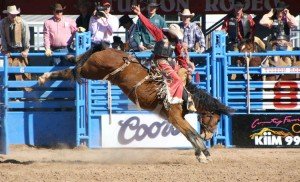
As many people are aware, the horse was introduced into North America by the early southwest Spanish explorers. The first significant Spanish expedition was that of Coronado in 1540. Coronado brought with him cattle and the vaquero, the Spanish cowboy. With the vaquero came the first Spanish saddles seen in America. They were the cattle handlers and horse trainers in Spanish culture.
The western saddle was designed to be comfortable, or as comfortable as possible, since it was used by the American cowboy who spent many hours on them. It was an essential cowboy tool for riding the range.
McClellan Saddle
Named after the American army officer, George B. McClellan, the McClellan Saddle was used extensively by the U.S. military beginning in 1859. The McClellan saddle was standard issue by the US War Department in 1859 for the U.S. Cavalry for the entire history of the horse cavalry into the 1940’s. During that time there were several different models of the McClellan Saddle, beginning with the M1859 and ending with the M1929.
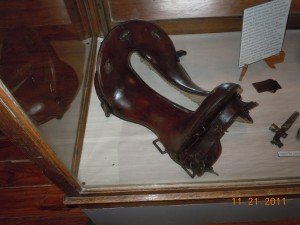
George McClellan came up with his saddle design after spending time in Europe during the mid 1850’s. His tour of Europe was to learn the latest developments in field cavalry equipment. The McClellan saddle design is a direct result from that European trip. The saddle McClellan designed is very similar to the Spanish tree saddle which was originally a saddle used in Mexico from that countries Spanish heritage. McClellan;s saddle was relatively inexpensive, was light weight and offered excellent support for the rider. These attributes were welcomed by the U.S. War Department.
Roping Saddle
The Roping Saddle is a version of the Western Saddle. As the name implies, the Roping Saddle is designed as a ranch work saddle. You could also say it is a Cowboy Saddle. The typical roping saddle has a deep seat and strong tree and horn.
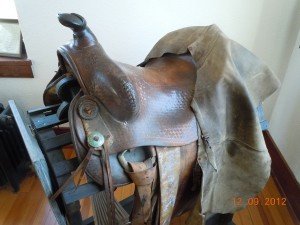
The horn is typically stronger to secure the rope and a strong tree is especially important roping stability. A saddle tree is the base on which the rest of the saddle is constructed. It’s similar to a chassis on an automobile. The saddle tree size determines the overall size of the saddle and how the saddle fits on the horses back. The saddle tree is made from wood or a synthetic material and is covered by leather.
Western Show Saddle
The show saddle is very much as the name implies. The show saddle is made for looking good. It’s a decorative saddle. It’s a western saddle you would see in parades, during horse shows and at special events. Where the roping saddle is a work saddle and is built as such, the show saddle is constructed to be a pleasing to the eye.
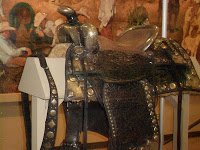
These decorative saddles are for the horse show arena and their design and construction usually mirror current fashion trends more than any of the other western saddle varieties. Because of this, styles come in and out of fashion.
A typical show saddle will have silver and deep tooling. The horn may be shorter so as not to interfere with the reins. A show saddle might have large medallions and corner plates. The saddle would have tooled skirts and the lacing on the leather might be another decorative attribute. Sewn trim on the show saddle’s edge adds another element of decorative design.
You’ll also enjoy our Trips Into History articles about Cattle Drives and Cowboys and the Rodeo Cowgirls.
Texas and Oklahoma Museums and Venues Exhibiting Western Saddle Collections
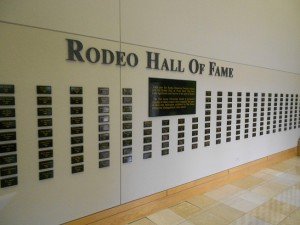
National Cowboy and Western Heritage Museum– Located in Oklahoma City, this large museum has excellent exhibits of saddles and everything cowboy. Included are several trophy saddles and a indoor rodeo exhibit.
Fort Reno Oklahoma– Located about twenty miles west of Oklahoma City, Fort Reno’s Visitors Center features saddles, photos and artifacts. Fort Reno operated from 1876 to 1949. Fort Reno also has a lot of information on the buffalo soldiers who occupied the fort during the late 1800’s and early 1900’s.
Fort Stockton– Old Fort Stockton is located on the east side of present day Fort Stockton Texas. The fort museum which is located in an old barracks building has an excellent collection of saddles, cavalry equipment and firearms plus exhibits of army uniforms from the mid to late 1800’s. Fort Stockton is located in southwest Texas along Interstate 10 between San Antonio and El Paso.
Limon Museum and Railroad Park– Located in Limon Colorado, this museum has a Saddle Boxcar exhibit.The 1890 Western saddle Boxcar brings back the era when every town had a saddle maker and the saddle was an important part of cowboy life. Many of the displayed saddles had belonged to well known area ranchers. Limon is located about a 90 mile drive southeast of Denver Colorado.
(Photos from author’s private collection. Bronco Buster photo from the public domain)
>
